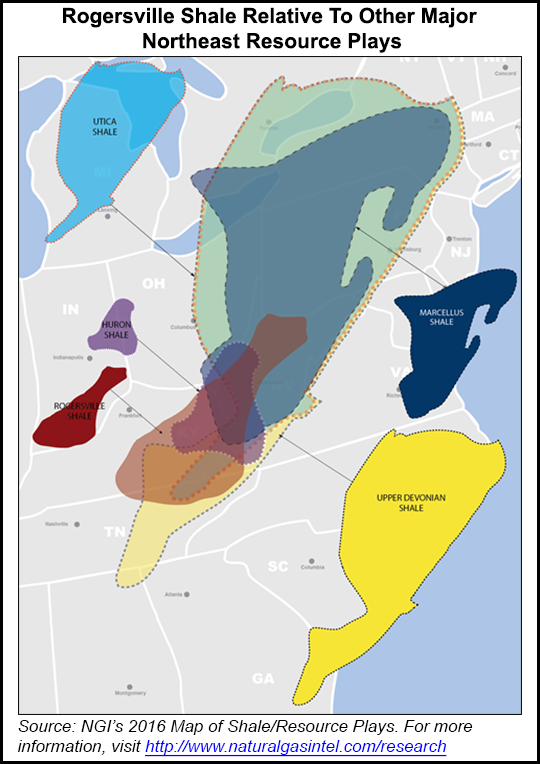E&P | NGI All News Access | NGI The Weekly Gas Market Report
Downturn Brings Rogersville Shale Exploration To ‘Stand-Still’
The momentum that has been slowly gained in exploring the Rogersville Shale in Eastern Kentucky and Southwest West Virginia appears to have come to a halt, with little drilling and no new permitting activity reported in the nascent play since late last year, according to state records and sources tracking development.

Seven Rogersville test locations have been permitted since 2013, when Cimarex Energy Co. subsidiary Bruin Exploration LLC was issued the play’s first stratigraphic test permit in Lawrence County, KY, that year (see Shale Daily, July 24, 2015).
NGI’s Shale Daily reported last year that Charleston, WV-based Hard Rock Exploration Inc. had applied for a vertical Rogersville test permit in Putnam County, WV (see Shale Daily, Nov. 13, 2015). West Virginia Department of Environmental Protection spokesperson Kelley Gillenwater said this week that the company was issued that permit in November.
Gillenwater said the application proposed a total depth of 15,000 feet for a well near Winfield, WV, where Cabot Oil & Gas Corp. has already drilled a vertical Rogersville well that’s producing natural gas to sales. Since Hard Rock was issued its permit late last year, no new activity has been reported, state officials said.
“There has been no new activity or permits,” said David Harris, head of the Energy and Minerals Section at the Kentucky Geological Survey. “Low prices have brought things to a stand still. I’m not sure when it will turn around.”
Other than Hard Rock, Cabot and Cimarex, an EQT Corp. affiliate and Chesapeake Energy Corp. have permits in the play. Cabot, Cimarex, Chesapeake and EQT have drilled a combined five test wells in both Kentucky and West Virginia. EQT is the only operator that has completed a horizontal Rogersville well, but Chesapeake filed last year for a horizontal permit in Kentucky at one of its vertical test sites in Lawrence County.

Just one to two rigs had been running in the state through the first three months of the year, before the count dropped to zero. By late April, however, three were running. Two of those are vertical oil rigs, but one is a horizontal gas-focused rig, with a total measured depth of 10,000-15,000 feet in Lawrence County, according to Baker Hughes rig data.
While Lawrence County is a hotbed for Berea Sandstone operations, that depth strongly suggests the profile of a Rogersville well. It remains unclear if Chesapeake is operating that rig, which was still running at the end of last week. The company has not commented about its exploration efforts in the play.
In August, Cimarex’s Sylvia Young No. 1 vertical well in Lawrence County showed initial test volumes of just 19 b/d of oil and 115 Mcf/d of natural gas, according to a completion report released last year by the Kentucky Division of Oil and Gas (see Shale Daily, Aug. 20, 2015). All other test wells are currently protected by state confidentiality laws. The results won’t be released for about a year (see Shale Daily, Sept. 23, 2015).
The Rogersville slowdown comes at a time when other plays in Kentucky are experiencing similar trends. A renaissance in Berea Sandstone drilling that began with the widespread application of horizontal hydraulic fracturing in 2011 has helped push oil production to new levels statewide. Oil production was 4.08 million bbl in 2014, state data shows, but it dropped significantly last year to 2.8 million bbl as a result of the decline in oil prices. While rigs have declined in West Virginia, production volumes have been sustained by Marcellus and Utica shale wells (see Shale Daily, March 9).
© 2024 Natural Gas Intelligence. All rights reserved.
ISSN © 2577-9877 | ISSN © 1532-1266 | ISSN © 2158-8023 |
